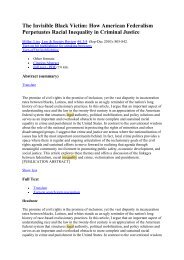Ski – resort and regional development: profile of visitors ... - E-Journal
Ski – resort and regional development: profile of visitors ... - E-Journal
Ski – resort and regional development: profile of visitors ... - E-Journal
Create successful ePaper yourself
Turn your PDF publications into a flip-book with our unique Google optimized e-Paper software.
46<br />
Filio Lazana, Diana Draganescu, Georgiana Grama, Magdalina Yarichkova<br />
Travel decisions potentially involve all the forms <strong>of</strong> risk, as identified by Dowling <strong>and</strong> Staelin<br />
(1994), namely functional risk (actual performance), social risk (embarrassment), physical<br />
risk (risk to self), psychological risk (bruised ego) <strong>and</strong> time risk (wasted).<br />
Early work within travel literature by Cohen (1972) identified four types <strong>of</strong> tourists based on<br />
their relative preferences for either familiarity or novelty <strong>of</strong> a travel destination. Most broadly,<br />
one group preferred destinations <strong>and</strong> circumstances to which they felt familiar (‘organised<br />
mass tourist’). Another group preferred novelty, where the circumstances were unfamiliar.<br />
The group seeking novelty would have a lower perception <strong>of</strong> risk <strong>and</strong> in turn appreciate <strong>and</strong><br />
find desirable “an acceptable level <strong>of</strong> risk”.<br />
Roehl <strong>and</strong> Fesenmaiser (1992) suggest another perspective, which classified tourists into three<br />
groups based on their perception <strong>of</strong> risk. These were risk neutral, those who did not consider<br />
tourism or destination choice to involve risk; ‘functional risk’, those who considered the<br />
possibility <strong>of</strong> operational or organizational failure as the primary source <strong>of</strong> potential risk;<br />
those who were risk aware if not anticipatory. According to Sonmez et al., (1999), essential<br />
for the recovery <strong>of</strong> a destination in the eyes <strong>of</strong> consumers is some demonstrable success in<br />
terms <strong>of</strong> the actual level <strong>of</strong> safety <strong>and</strong> security at the destination. As Francesco Frangialli, the<br />
secretary general <strong>of</strong> the WTO, declared, ‘we have learned from experience that the tourism<br />
industry recovers very quickly from adversity’ (Quinn, 2003). Evidence has been brought to<br />
show that, at times <strong>of</strong> global or <strong>regional</strong> heightened awareness <strong>of</strong> risk, where the actual country<br />
or region does not experience any such risks, the recovery is quite swift.<br />
Various studies have found that, in addition to the differences in recovery times in terms <strong>of</strong><br />
location relative to the specifically afflicted destinations, the impact <strong>of</strong> terrorism can be delayed<br />
from between three <strong>and</strong> nine months after the event took place (Enders <strong>and</strong> S<strong>and</strong>ler, 1991;<br />
Sonmez et al., 1994). The delay in impact has been variously attributed to the consumer<br />
perception that there is a low probability <strong>of</strong> an immediate repeat <strong>of</strong> the incident or that postincident<br />
media coverage heightens consumer awareness <strong>of</strong> the locale (Enders et al., 1992).<br />
Furthermore, it st<strong>and</strong>s under discussion the proposition that factual information for centrally<br />
processed attitude formulators should be targeted to males rather than females as males are<br />
less risk aversive (Hall, 1996; Gibson <strong>and</strong> Jordan, 1998; Carr, 2001). A study by Elsrud (2001)<br />
found an actual positive perception <strong>of</strong> risk by males. However, another study by Sonmez <strong>and</strong><br />
Graefe (1998) found that gender was not an influence on risk perception. In addition to gender,<br />
there is some evidence that the post-terrorist marketing should be more targeted to younger<br />
rather than old consumers. A study by Gibson <strong>and</strong> Yiannakis (2002) <strong>of</strong> the tourist role<br />
preference over the life course found that preference for risk-related tourism tended to decrease<br />
with age.<br />
In his paper entitled “Tourism Security, Different Places/Different Faces”, Dr. Tarlow (2006),<br />
mentions some <strong>of</strong> the principle locations at high risk from terrorism such as transportation<br />
hubs, hotels <strong>and</strong> conventions, cruises, restaurants, shopping centers, amusement parks, festivals<br />
Tourism Today - Fall 2007 - Full Paper














